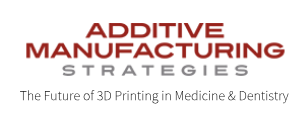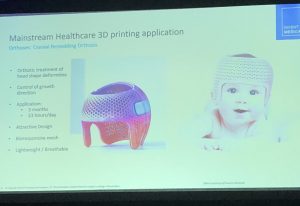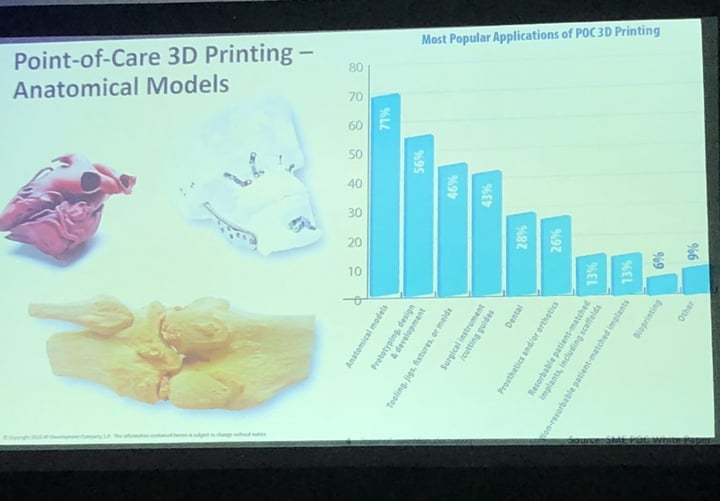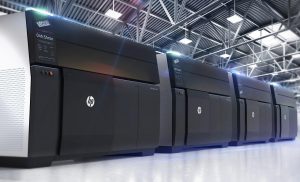by Sarah Saunders | Jan 31, 2019 | 3D Printing, 3D Printing Events, Medical 3D Printing |
Our second annual Additive Manufacturing Strategies summit, held in Boston and co-hosted by SmarTech Markets Publishing, is in full swing after Tuesday’s two featured workshops. This year’s AMS event, “The Future of 3D Printing in Medicine and Dentistry,” now includes a track each for medical and dental 3D printing, along with a startup competition, an exhibition floor with 12 booths, and even more speakers.
 Yesterday morning, Lawrence Gasman, the President of SmarTech Markets Publishing, officially opened the summit, and had some exciting news to share – while last year’s AMS had participants from roughly 11 countries, this year 24 countries, along with 27 US states, are represented. Gasman mentioned that the hope is for the AMS summit to be rooted in the entire healthcare industry, before introducing Dr. Ali Tinazli, the Head of Healthcare and Life Sciences Strategy for HP and the day’s keynote speaker.
Yesterday morning, Lawrence Gasman, the President of SmarTech Markets Publishing, officially opened the summit, and had some exciting news to share – while last year’s AMS had participants from roughly 11 countries, this year 24 countries, along with 27 US states, are represented. Gasman mentioned that the hope is for the AMS summit to be rooted in the entire healthcare industry, before introducing Dr. Ali Tinazli, the Head of Healthcare and Life Sciences Strategy for HP and the day’s keynote speaker.
Dr. Tinazli has been leading HP’s corporate-wide, global strategy for Healthcare and Life Sciences since 2015, and though he referred to himself as a “3D print novice,” spoke today about “3D Printing Going Mainstream for Health 4.0,” with the main theme centered around the democratization of medicine and the implications. He is currently working on a healthcare testing ecosystem made up of mobile diagnostics and small microfluidic parts, and, as a self-proclaimed fan of technology convergence, noted with admiration that an event such as AMS would not have been possible even a few years ago.
After giving a brief history of HP, which celebrates its 80th anniversary this year, and how it is “using technology to make a better future for everyone,” Dr. Tinazli explained why 3D printing excites him; the reasons include the fact that 3D printing is connecting HP’s core technology, can be used to customize products, and is also “the catalyst for the fourth industrial revolution” by enabling faster innovation. He noted that democratization is helping to make technologies, such as 3D printing, available to everyone.
 Dr. Tinazli discussed blended reality, where the physical world tells us how to shape certain things and we then use this information to automate and digitize it. A good example of this is using CT scans to build medical devices and implants, which are then 3D printed and used on patients.
Dr. Tinazli discussed blended reality, where the physical world tells us how to shape certain things and we then use this information to automate and digitize it. A good example of this is using CT scans to build medical devices and implants, which are then 3D printed and used on patients.
He noted that some specific megatrends (slow-changing, transformative, global trends), such as decentralized healthcare and an aging population, are indicating a transformation in life sciences, which, when paired with 3D printing, could create some major opportunities for disruption in healthcare.
3D printing is reinventing industries and “making the leap to factory production,” and Dr. Tinazli noted some of the economic justifications for adopting the technology, such as:
- making objects at a faster speed, with less waste and low risk
- ability to fabricate unique geometries on a massive scale
- mass customization
- scalable
 While he noted that some of his favorite 3D printing topics are art and fashion (like me!), Dr. Tinazli said that healthcare is the oldest industry benefiting from the technology – current applications include skull patches, hearing aids, custom orthotics, prosthetics, insoles, and surgical planning.
While he noted that some of his favorite 3D printing topics are art and fashion (like me!), Dr. Tinazli said that healthcare is the oldest industry benefiting from the technology – current applications include skull patches, hearing aids, custom orthotics, prosthetics, insoles, and surgical planning.
He noted four classes of mainstream healthcare applications – orthodontics, dental prosthetics, hearing aids, and orthopedics – that see a combined 400,000 custom medical devices 3D printed per day…an impressive number, indeed.
Dr. Tinazli moved on to discuss some of the many innovative companies using 3D printing for medical applications, starting with the startup Smile Direct Club, which either delivers an impression kit directly to a customer’s home or has one of its remote SmileShops scan the teeth in order to fabricate custom dental aligners. Dr. Tinazli noted that dental is in an “interesting growth phase,” and also mentioned nivellipso, a Swiss company that uses HP’s MJF technology to 3D print dental molds.
One of Dr. Tinazli’s favorite examples is the custom earbud manufacturing solution that Formlabsdebuted at CES 2018. He noted that the earbuds are made with the same technology and workflow as custom 3D printed hearing aids are, which is an excellent example of 3D printing solutions in the clinical world being applied to consumer products.
“The more I learn about new technologies, the more I think it’s about the user experience,” he stated.
This was the perfect segue to the 3D printed UNYQ Align scoliosis brace, which is far more pleasant for teenage patients to wear for 24 hours than the traditional braces, which are typically heavy and far too hot.
Dr. Tinazli said, “User experience, even in medicine, neglected over the past decades, is getting better.”
Another example he brought up was HP’s FitStation platform, which is using 3D printing to deliver individualized, custom-fitting footwear and orthotics.
“Clinical applications can have an impact on the consumer,” Dr. Tinazli said.
The talk then moved on to point-of-care (POC) 3D printing, and how the use of 3D printed anatomical models before surgery can decrease the length of the operation, which in turn saves on cost and improves the patient’s experience and surgical outcome. This is where full-color 3D printing, which Dr. Tinazli called “a strong domain of HP,” can be very helpful.
 He also touched on additional 3D printing applications that HP technology is being used to make, such as more comfortable cranial helmets for infants, prosthetics and sockets for braces, and eyewear.
He also touched on additional 3D printing applications that HP technology is being used to make, such as more comfortable cranial helmets for infants, prosthetics and sockets for braces, and eyewear.
Using the Jet Fusion 4210 3D printer, Dr. Tinazli said that it will only cost $700-800 for an entire build of 322 sunglass parts, which makes it possible to sell them “at a profit.”
In addition, the MJF 300/500 3D printer series is able to make sunglasses that have custom designs, like Minecraft-themed, and can even include QR codes to help lower the risk of counterfeiting.
Finally, Dr. Tinazli mentioned HP’s “latest baby: Metal Jet Fusion,” which was introduced in late 2018 and allows companies to “dive instantly into mass production.” Additionally, it can also be used for medical applications, such as 3D printing surgical devices and tools.
Then came the question and answer portion of the keynote. Someone asked what industries will be most immediately impacted by HP’s Metal Jet Fusion; Dr. Tinazli replied that HP is going after professional users in high value mass markets, like automotive and medical.
Another attendee asked about specific patient populations being looked at by HP.
“From 3D printing, we look at it as more of a B2B business, and it’s up to the companies we work with,” Dr. Tinazli answered. “We do not have any immediate exposure to patients.”
He expounded on this answer further during the next question, when a facial surgeon in the audience asked about the entire workflow of 3D printing in healthcare, in terms of training technicians and physicians to use the equipment to fabricate customized models, and if HP was doing anything to address the full spectrum of care, rather than just providing the 3D printer itself.
“We have all these internal debates about how deep we’re going into the service,” Dr. Tinazli answered, stating that the company could very easily find itself in the service business and competing with healthcare customers.
“That’s why we look at it as B2B. Otherwise we would be getting too close to our customers…definitely more lucrative, but presently we don’t do that.”
We’ll have more to share with you from AMS 2019, so stay tuned!
Discuss this and other 3D printing topics at 3DPrintBoard.com or share your thoughts below.
[Images: Sarah Saunders unless otherwise noted]






